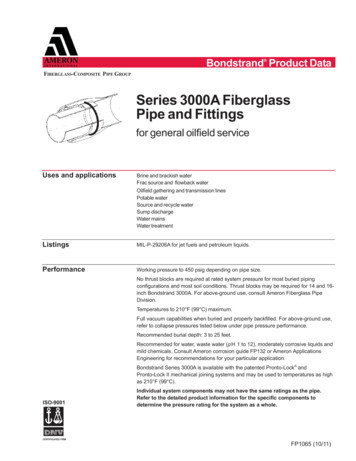New Jersey’s Freight Rail Connection
New Jersey’s Freight Rail ConnectionApril 18, 2016Office of Vice President/Chief Engineer
Conrail connects New Jersey to the North Americanfreight rail network Transitioned from a Class 1 to a Switching and Terminal carrier in 1999– 1200 miles in 3 regional areas– 1150 employees Conrail provides direct service with head-to-head competition among twoClass 1 railroads – CSX and Norfolk Southern Conrail interchanges with 11 of 14 New Jersey shortline railroads, providingsafe, reliable, and efficient rail service to our customers Contributes to New Jersey through employment and economic developmentas an environmentally friendly transportation alternative1
Conrail provides safe and reliable freight transport serviceto New Jersey businesses 225 companies are served in 16 counties within New Jersey Nearly 300,000 carloads are delivered annually to customers within the stateo Equivalent to 1.1 million truck loads removed from New Jersey highwayso Every ton mile of freight moved by rail versus truck reduces greenhouse emissionsby two-thirds Commodities delivered support a wide range of commerce from agricultural tohousing and construction to health care2
Conrail –North Jersey Metropolitan AreaCSX River LineSuffernRidgefield Hgts.NS Southern TierCSAONorth BergenHXCSXPassaic Jct.CroxtonNSAMTRAKMARIONSouth KearnyCR P&H BranchOak IslandGREENDoremus AveALDENELANEDocksideCR Lehigh LineLindenCR Port Reading SecondaryPT READING JCT.PHILIPSBURGPort Reading.MetuchenWOODManvilleMIDWAYCSX Trenton LineWINGStatenIslandCR Garden State SecRAHWAYBOUND BROOKBayonneBaywayAmtrak NECNS Lehigh LineTo NYCNAVEBrownsESSAYREDBANKTo TRENTON4Lakehurst3
Conrail makes significant investments that enhance safety,improve service, and expand capacity in New Jersey Over 370 million has been invested from 2000 to 2015 In addition, over 145 million of additional investment has been madethrough public-private partnerships benefiting New Jersey In 2015 alone, nearly 31 million was invested in New Jersey projects Conrail expends over 76 million annually in New Jersey to operate andmaintain rail infrastructure, providing safe and reliable service4
Conrail partners with agencies in New Jersey to coordinateintermodal transportation as well as participation inpublic/private partnerships Local and county agencies New Jersey Department of Transportation New Jersey Transit and its commuter agencies Port Authority of NY/NJ North Jersey Transportation Planning Authority Amtrak5
Conrail’s Ongoing Focus and Commitment Managing risk associated with our human and physical assets Providing superior service to customers and short line partners on behalf ofCSX and Norfolk Southern– Technological innovations Being visible in future freight and passenger rail initiatives Staying ahead of double digit growth at ports in New York and New Jersey Smart investments– Keep existing and attract new business– Public/Private projects– Add capacity to enhance service Development of Greenville Yard PTC Raising the 263K weight capacity limit on Amtrak and New Jersey Transit lines6
to New Jersey businesses 225 companies are served in 16 counties within New Jersey Nearly 300,000 carloads are delivered annually to customers within the state o Equivalent to 1.1 million truck loads removed from New Jersey highways o Every ton mile of freight moved by rail versus truck reduces greenhouse emissions by two-thirds
Figure 1-10 New Jersey Rail System–Post Conrail 1-18 Figure 1-11 New Jersey Rail System–The Aldene Plan 1-21 Figure 1-12 New Jersey Transit Rail System 1-24 Figure 1-13 U.S. Greenhouse Gas Emissions in 2009 by Economic Sector 1-26 Figure 2-1 New Jersey Rail System Ownership 2
freight journey by maximising rail trunk haul and minimising some elements of the secondary distribution leg by road, through co-location of other distribution and freight activities. SRFIs are a key element in reducing the cost to users of moving freight by rail and are important in facilitating the transfer of freight from road to rail .
3. LCA of rail freight transport 4. LCA of IWW transport 5. LCA of road freight transport 6. Comparison of the environmental impacts of the transport modes III. Environmental impact assessment of freight transport 7. Study of intermodal freight transport routes 8. Study of the modal split of inland freight transport in Belgium IV. Conclusions .
a visit to Laredo, TX, where FRA observed both north and southbound freight train movements on the International Bridge in Laredo, which has the most freight rail traffic among the southern border rail ports of entry (POEs). The Study found standards and protocols for freight rail service between Mexico and the U.S.,
Appendix 9 – Rail Freight Projects. Appendix 9. Freight Rail Projects . In an effort to identify the capital needs of the freight industry in Pennsylvania, PennDOT conducted an extensive outreach initiative, in coordination with the Keystone State Railroad Association, to secure input fr
Freight Rail also transports a broad range of bulk general freight commodities and containerised freight. The division maintains a complex rail network of approximately 31 000 track kilometres (20 900 route kilometres) over which commo
Bottom rail, mid & top railS Top Rail Mid-Rail Bottom Rail how to measure mid-rail height When measuring the mid-rail height it is important to measure to the center point of where you would like the mid-rail to be placed. As the mid-rail is the same size as an individual louver, it will be placed approximately /- 1” for the specified height.
Pipe Size ASTM Designation (in) (mm) (D2310) (D2996) 2 - 6 50 - 150 RTRP 11FX RTRP 11FX-5430 8 - 16 200 - 400 RTRP 11FX RTRP 11FX-3210 Fittings 2 to 6-inch Compression-molded fiberglass reinforced epoxy elbows and tees Filament-wound and/or mitered crosses, wyes, laterals and reducers 8 to 16-inch Filament-wound fiberglass reinforced epoxy elbows Filament-wound and/or mitered crosses, wyes .























